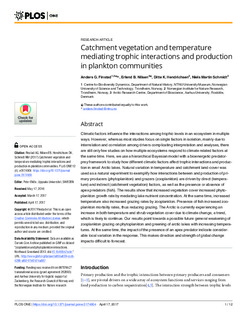| dc.contributor.author | Finstad, Anders Gravbrøt | |
| dc.contributor.author | Nilsen, Erlend Birkeland | |
| dc.contributor.author | Hendrichsen, Ditte Katrine | |
| dc.contributor.author | Schmidt, Niels M. | |
| dc.date.accessioned | 2017-05-04T08:36:16Z | |
| dc.date.available | 2017-05-04T08:36:16Z | |
| dc.date.created | 2017-04-21T20:08:25Z | |
| dc.date.issued | 2017 | |
| dc.identifier.issn | 1932-6203 | |
| dc.identifier.uri | http://hdl.handle.net/11250/2441619 | |
| dc.description.abstract | Climatic factors influence the interactions among trophic levels in an ecosystem in multiple ways. However, whereas most studies focus on single factors in isolation, mainly due to interrelation and correlation among drivers complicating interpretation and analyses, there are still only few studies on how multiple ecosystems respond to climate related factors at the same time. Here, we use a hierarchical Bayesian model with a bioenergetic predator-prey framework to study how different climatic factors affect trophic interactions and production in small Arctic lakes. Natural variation in temperature and catchment land-cover was used as a natural experiment to exemplify how interactions between and production of primary producers (phytoplankton) and grazers (zooplankton) are driven by direct (temperature) and indirect (catchment vegetation) factors, as well as the presence or absence of apex predators (fish). The results show that increased vegetation cover increased phytoplankton growth rate by mediating lake nutrient concentration. At the same time, increased temperature also increased grazing rates by zooplankton. Presence of fish increased zooplankton mortality rates, thus reducing grazing. The Arctic is currently experiencing an increase in both temperature and shrub vegetation cover due to climate change, a trend, which is likely to continue. Our results point towards a possible future general weakening of zooplankton grazing on phytoplankton and greening of arctic lakes with increasing temperatures. At the same time, the impact of the presence of an apex predator indicate considerable local variation in the response. This makes direction and strength of global change impacts difficult to forecast. | nb_NO |
| dc.language.iso | eng | nb_NO |
| dc.publisher | Public Library of Science | nb_NO |
| dc.rights | Navngivelse 4.0 Internasjonal | * |
| dc.rights.uri | http://creativecommons.org/licenses/by/4.0/deed.no | * |
| dc.title | Catchment vegetation and temperature mediating trophic interactions and production in plankton communities | nb_NO |
| dc.type | Journal article | nb_NO |
| dc.type | Peer reviewed | nb_NO |
| dc.source.volume | 12 | nb_NO |
| dc.source.journal | PLoS ONE | nb_NO |
| dc.source.issue | 4 | nb_NO |
| dc.identifier.doi | https://doi.org/10.1371/journal.pone.0174904 | |
| dc.identifier.cristin | 1466008 | |
| dc.description.localcode | © 2017 Finstad et al. This is an open access article distributed under the terms of the Creative Commons Attribution License, which permits unrestricted use, distribution, and reproduction in any medium, provided the original author and source are credited. | nb_NO |
| cristin.unitcode | 194,31,10,0 | |
| cristin.unitname | Seksjon for naturhistorie | |
| cristin.ispublished | true | |
| cristin.fulltext | original | |
| cristin.qualitycode | 1 | |

